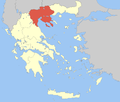Central Macedonia
Central Macedonia
Κεντρική Μακεδονία | |
|---|---|
 | |
| Coordinates:40°42′N23°00′E/ 40.7°N 23.0°E | |
| Country | |
| Region | |
| Decentralized administration | Macedonia and Thrace |
| Capital | Thessaloniki |
| Regional units | |
| Government | |
| • Regional Governor | Apostolos Tzitzikostas(New Democracy) |
| Area | |
| • Total | 18,810.52 km2(7,262.78 sq mi) |
| Population (2021)[1] | |
| • Total | 1,795,669 |
| • Density | 95/km2(250/sq mi) |
| Demonym | Macedonian |
| GDP | |
| • Total | €24.892 billion (2021) |
| Time zone | UTC+2(EET) |
| • Summer (DST) | UTC+3(EEST) |
| ISO 3166 code | GR-B |
| HDI(2019) | 0.876[3] very high·6th of 13 |
| Website | www |
Central Macedonia(/ˌmæsəˈdoʊniə/MASS-ə-DOH-nee-ə;Greek:Κεντρική Μακεδονία,romanized:Kentrikí Makedonía,IPA:[ce(n)driˈcimaceðoˈni.a]) is one of the thirteenadministrative regionsofGreece,consisting of the central part of thegeographical and historical region of Macedonia.With a population of almost 1.8 million, it is the second most populous region in Greece afterAttica.
Geography[edit]
The region of Central Macedonia is situated inNorthern Greece,bordering theregionsofWestern Macedonia(west),Thessaly(south),Eastern Macedonia and Thrace(east), and bounded to the north at the international borders of Greece by theRepublic of North MacedoniaandBulgaria.The southern part is coastal and is bathed by theThermaic,Toroneos,SingiticandStrymonicgulfs. The largest city and capital of the region isThessaloniki.Serresis the second most populous city, followed byKaterini,VeriaandGiannitsa.Central Macedonia is basically lowland and, with many rivers, is highly developed, both in the primary and the secondary sectors. The largest plain inGreeceis situated in Central Macedonia.Thessaloniki,the metropolis ofMacedonia,is Greece's second largest city. The highest mountains of the region of Central Macedonia areMount Olympus(2,918 m.),Voras Mountains(2,524 m.),Pierian Mountains(2,193 m.),Vermio Mountains(2,065 m.) andMount Athos(2,033 m.). The largest rivers are theHaliacmon,theAxios,theLoudiasand theGallikos (Echedoros),which all flow into theThermaic Gulf.Koroneia,Volvi,DoiranandKerkinilakes are situated in Central Macedonia. The coasts are continuous, smooth, sandy and suitable for swimming (except the estuaries and the shores of the urban complex of Thessaloniki).
Administration[edit]
The region was established in the 1987 administrative reform as theCentral Macedonia Region(Greek:Περιφέρεια Κεντρικής Μακεδονίας,romanized:Periféria Kentrikís Makedonías). With the 2010Kallikratis plan,its powers and authority were redefined and extended. Along withEastern Macedonia and Thrace,it is supervised by theDecentralized Administration of Macedonia and Thrace,based inThessaloniki.The region is based at its capital city ofThessalonikiand is divided into sevenregional units(pre-Kallikratisprefectures),Chalkidiki,Imathia,Kilkis,Pella,Pieria,SerresandThessaloniki.These are further subdivided into 38municipalities.
Although geographically part of Central Macedonia,Mount Athosis not administratively part of the region, but an autonomous self-governing state under the sovereignty of Greece.
Demographics[edit]
The region has shrunk by 90,039 people between2011and2021,experiencing a population loss of 4.8%.[1][4]
History[edit]
Themodern Greek regionof Central Macedonia roughly corresponds to theancient Greek regionofLower Macedonia,which included the center and two capitals,Aigai (Vergina)andPella,ofancient Macedonia.Pellawas the birthplace ofAlexander the Great.
Economy[edit]
In 2011, theGDP per capitaof Central Macedonia was€14,400, marking a 9th place of the 13 regions of Greece, well below the national average of€18,500.[5]
Tourism[edit]
Central Macedonia is Greece'sfourth-most-populartourist region and the most popular destination that is not anisland.[6]TheChalkidikipeninsula isMacedonia's most popular beach destination, combining 550 kilometres (340 mi) of sandy beaches with dense forests.[7]There were 116Blue Flag beachesin Macedonia in 2018, 85 of which were in Chalkidiki.[8]Chalkidiki is also home to Mount Athos, which is an important center of religious tourism.Pieriacombines extensive plains, high mountains and sandy beaches and the region's beauty gives it a great potential for further tourist development. It is estimated that 10,000 people climbMount Olympuseach year, most of them reaching only the Skolio summit. Most climbs of Mount Olympus start from the town ofLitochoro,which took the name City of Gods because of its location at the foot of the mountain. Central Macedonia is home to the ancient city ofAigai(modern dayVergina), one ofGreece's 18 UNESCO World Heritage sites,which was the first capital ofancient Greek kingdom of Macedon.In 336 BCPhilip IIwas assassinated in Aigai's theatre and his son,Alexander the Great,was proclaimed king. The most important recent finds were made in 1977 when the burial sites of several kings of Macedon were found, including the tomb ofPhilip II of Macedon.It is also the site of an extensive royal palace.The archaeological museum of Verginawas built to house all the artifacts found at the site and is one of the most important museums in Greece.Pella,which replaced Aigai as the capital of Macedon in the fourth century BC, is also located in Central Macedonia, as well asDioninPieriaandAmphipolis.These are important destinations forcultural tourism.Thessalonikiis home to numerous notableByzantine monuments,including thePaleochristian and Byzantine monuments of Thessaloniki,aUNESCOWorld Heritage Site,as well as severalRoman,Ottoman andSephardic Jewishstructures. Apart from being the cultural center of Macedonia,Thessalonikiis also a hub for urban tourism andgastronomy.[9]
Major cities and towns[edit]
References[edit]
- ^ab"Census 2021 GR"(PDF)(Press release).Hellenic Statistical Authority.2022-07-19.Retrieved2022-09-12.
- ^"Population on 1 January by age, sex and NUTS 2 region",Eurostat
- ^"Sub-national HDI - Area Database - Global Data Lab".hdi.globaldatalab.org.Retrieved2021-07-20.
- ^"Σε 10.432.481 υπολογίζεται ο πληθυσμός της Ελλάδας - Είμαστε 383.805 λιγότεροι σε σχέση με το 2011 (βίντεο)".Macedonia Newspaper(in Greek).Retrieved2023-07-14.
- ^"Gross domestic product (GDP) at current market prices at NUTS level 2".Eurostat regional yearbook.Eurostat.Retrieved3 April2015.
- ^"Greece in Figures 2018".Hellenic Statistical Authority.
- ^"Macedonia: a region of a thousand landscapes".Discover Greece.Retrieved2019-02-09.
- ^"Γαλάζιες Σημαίες 2018"[Blue Flags 2018]. eepf.gr.Retrieved2019-02-10.
- ^"Macedonia travel – Greece".Lonely Planet.Retrieved2019-02-09.
External links[edit]
- Official website
 (in Greek)
(in Greek)


